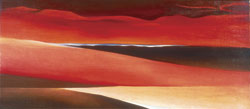
*pictured: 'Untitled (Desert Abstraction) (Bear Lake)' by Georgia O'Keeffe, 1931. Courtesy: Museum of New Mexico, Museum of Fine Arts, Museum of New Mexico Foundation, 1984.
Georgia O’Keeffe: Visions of the Sublime is an exhibition of anticipated and expected beautiful works that is also part art historical survey of this iconic American artist. The range of work shown covers her career, thus allowing the audience to easily tap into her pure intentions of conveying mood and emotion, or what is referred to in the show title as sublime. The show flowed well, following the development of her aesthetic sensibility.
This is partially accomplished with quotes from O’Keeffe (1887–1986) accompanying the 30 paintings in the show. These words lend a necessary element of insight that brings her art process to light and further enriches the concept of sublime.
One such quote reads, “I found that I could say things with colors and shapes that I couldn’t say in any other way, things I had no words for.”
And so her works are ultimately a sincere expression of her awe from interacting and experiencing nature, whether it was the blue color of a sky or a dry leaf.
Unlike the aesthetic conventions of 19th century artists like Turner, who created expansive landscapes reflecting a gloomier side of the sublime, O’Keeffe indulged in it in the early 20th century as emotion inspired by a thing or a place.
Examples of 19th century landscapes are shown toward the end of the exhibition space for a conceptual contrast that proved to be more visually abrupt than beneficial.
Perhaps their placement was intentional, as they followed a wall of Alfred Stieglitz’s small black and white cloud study photographs, the “Equivalents.” Steiglitz was O’Keeffe’s partner and a notable photographer who created the series of emotive moon and skyscapes based on her works. These photos were a weak link to the drama of the early landscapes. Indeed, the tail end sections of the exhibit were visually choppy and lighting was uneven everywhere.
Glare was noticeable with the “Equivalents” (crowded and stacked with the upper row too high above eye level for a comfortable view) as the emulsion even caught reflections — a reminder that the museum’s expansion is a welcomed advancement.
“Pelvis with the Distance,” a 1943 oil painting belonging to the Indianapolis Museum of Art, is an exceptional O’Keeffe work in the show featuring a weightless, sculptural, bleached pelvis bone encompassing the canvas and breaking a minimal southwest landscape in half. Though a showstopper, it shouldn’t have been placed isolated from the bulk of the show as a finale piece. Examining the smooth petal-like texture and silky blending of O’Keeffe’s paints was a chore as lighting created severe shadows for viewers of the work. Regardless, it’s a powerful work that embraces everything that set her work apart from other Modernists and/or Precisionists.
O’Keeffe innovations — softness, clean lines, enlarged studies, femininity and simplicity in flat applications of uncomplicated colors — are gracefully portrayed in a 1927 piece, “Skunk Cabbage.” Color is minimal with brown, green and yellow creating a realistic image broken down by form into a botanical abstraction of nature emotionally modified. Such paintings effectively lend poignancy to her unique visual voice whether you are an admirer of O’Keeffe or not.
“A red hill doesn’t touch everyone’s hearts as it touches mine,” another quote reads, revealing the heart of how O’Keeffe became the important American painter exemplified astutely in this show.
Georgia O’Keeffe: Visions of the Sublime continues through April 3 at the Eiteljorg Museum. For information: 636-WEST, www.eiteljorg.org.
No comments:
Post a Comment